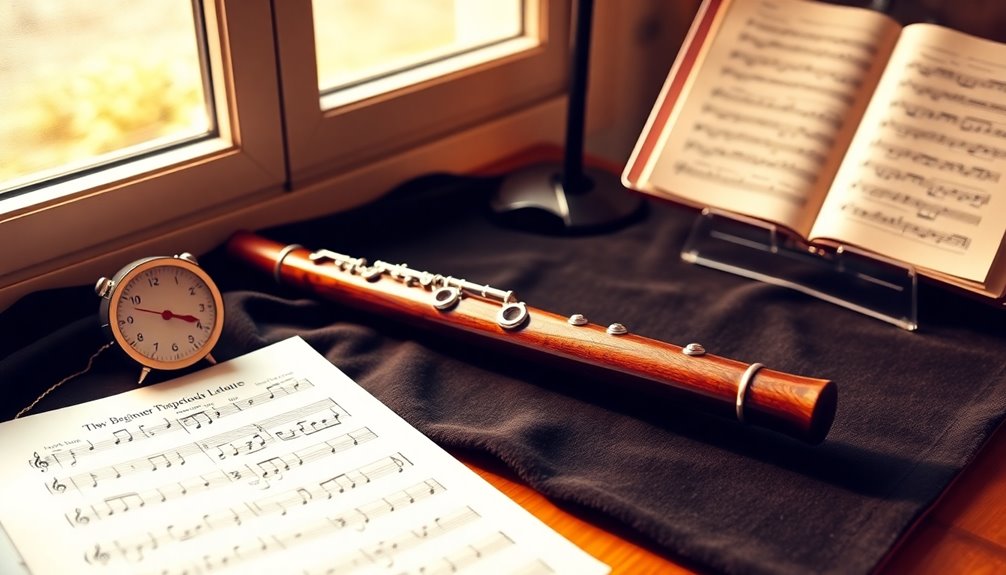Your first flute lesson is an exciting adventure! You'll start by learning about the flute's anatomy, including the headjoint, body, and footjoint. Understanding these parts is key to producing great sound. Next, you'll need essential equipment like a good beginner flute and a cleaning kit. Expect warm-ups focusing on breath control and posture, followed by simple melodies. Remember to practice regularly, aiming for 20-30 minutes daily, breaking it into warm-ups and exercises. With the right mindset and support, you'll see progress. If you keep exploring, you'll discover even more tips to enhance your flute journey!
Key Takeaways
- Familiarize yourself with the flute's anatomy: headjoint, body, and footjoint are essential for understanding sound production and pitch changes.
- Prepare essential equipment, including a quality flute, cleaning kit, music stand, and tuner for effective practice sessions.
- Expect warm-ups focused on breath control and posture, along with basic notes and finger placements in your first lesson.
- Stay motivated by setting personal goals, practicing consistently, and celebrating small achievements to track your progress.
- Engage with the flute community through online forums and resources to enhance your learning experience and connect with other musicians.
Understanding the Flute Anatomy

When you begin your journey with the flute, understanding its anatomy is fundamental to mastering this beautiful instrument. The flute consists of several key parts that work together to create the enchanting sounds you'll soon be producing. Familiarizing yourself with these flute parts will deepen your connection to the music and enhance your playing experience.
The main sections of the flute include the headjoint, body, and footjoint. The headjoint is essential for sound production; it contains the embouchure hole where you direct your breath. By adjusting your mouth shape and airflow, you can manipulate the sound's quality.
The body holds the majority of the keys, which you'll use to change pitch by covering and uncovering tone holes. Finally, the footjoint completes the instrument and houses additional keys that expand your range.
As you explore these parts, take time to appreciate their role in creating music. Each component contributes to the flute's voice, and knowing how they function together can inspire you to play with confidence. Understanding the anatomy also helps you troubleshoot issues, like leaks or sticking keys, so you can maintain your flute effectively. Additionally, learning about the different types of flutes, such as the concert flute, can enhance your appreciation for the instrument's versatility.
Embrace this learning process as an essential step in your musical journey. With each practice session, you'll not only grow familiar with the flute parts but also cultivate a deeper sense of belonging within the musical community.
Essential Equipment for Beginners

Now that you're familiar with the anatomy of the flute, it's time to gather the right equipment to kickstart your playing experience. First and foremost, you'll need a flute. When choosing a beginner flute, consider reputable flute brands like Yamaha or Gemeinhardt. These brands offer quality instruments that are perfect for new players, balancing affordability with good sound.
Once you've got your flute, think about essential accessories. A sturdy case is crucial for protecting your instrument during transport. You might also want to invest in a cleaning kit, which usually includes a cleaning rod and cloth. Keeping your flute clean is one of the best maintenance tips you can follow, guaranteeing it lasts for years to come.
Don't forget about a music stand! It'll help you keep your sheet music at eye level, making practice sessions more comfortable. A tuner can also be a valuable tool, helping you confirm your flute is in tune as you progress. Additionally, consider investing in a flute with a closed-hole key system, as it is recommended for easier finger placement and technique development.
Finally, consider joining a community or finding a local group of flute players. Connecting with others can provide encouragement and make your learning journey even more enjoyable.
What to Expect in Class

Curious about what your first flute class will be like? You're stepping into an environment designed to nurture your love for music and help you grow as a flutist. Understanding class expectations will ease any nerves and prepare you for an enjoyable experience.
Your lesson structure will typically begin with a warm-up. This will help you become comfortable with the flute and focus on your breath and posture. You'll likely spend some time learning basic notes, finger placements, and simple melodies. Your instructor will guide you through each step, ensuring you grasp the fundamentals before moving on to more complex techniques.
Expect a mix of individual attention and group collaboration. You'll be encouraged to ask questions, share your thoughts, and connect with fellow classmates. This supportive atmosphere fosters a sense of belonging and helps everyone learn from one another.
As the class progresses, you might incorporate some music theory, which will enhance your understanding of what you're playing. Don't worry if it feels overwhelming at first; your instructor will break everything down into manageable pieces. Additionally, understanding the importance of regular maintenance will keep your flute in optimal playing condition.
At the end of your first class, you'll likely feel a sense of accomplishment and excitement about your musical journey. Remember, everyone starts somewhere, and you're not alone in this experience. Embrace the learning process, and enjoy every moment as you set out on this new adventure!
Basic Techniques to Practice

Building on the foundation set during your first class, practicing basic techniques is essential for developing your flute skills. Focusing on these elements will help you become more comfortable and confident as you play.
Here are three key techniques to get you started:
- Breath Control: Your breath is the engine that drives your sound. To improve your breath control, practice taking deep breaths from your diaphragm. Try inhaling for four counts and exhaling for six. This will help you sustain notes longer and maintain a steady tone. Additionally, understanding the importance of core engagement can significantly enhance your breath support and overall tone quality.
- Finger Placement: Proper finger placement is fundamental for playing cleanly and efficiently. Spend time ensuring your fingers are curved and relaxed while hovering just above the keys. You can practice finger exercises, like moving between different notes, to develop muscle memory and increase your dexterity.
- Posture: Good posture is often overlooked but is essential for peak performance. Sit or stand up straight with your shoulders relaxed. This positioning allows you to breathe more effectively and reach the keys comfortably.
Tips for Success on Your Journey

Practicing regularly is essential for your growth as a flutist. Establishing a consistent practice routine not only builds your skills but also enhances your confidence. Start by setting aside a specific time each day for practice. Even 20-30 minutes can make a big difference.
Break your practice into focused segments, such as warm-ups, technique exercises, and pieces you're working on. This structure helps maintain your practice motivation and keeps you engaged.
Don't be discouraged by challenges. Every flutist faces hurdles, whether it's mastering a tricky passage or struggling with breath control. When you encounter difficulties, try breaking them down into smaller, manageable parts and tackle them one at a time.
Celebrate small victories along the way; they'll keep you motivated and remind you of your progress. Incorporating mindful breathing before practice can help center your focus and enhance your overall experience.
Joining a community of fellow flutists can also be incredibly beneficial. Connect with others who share your passion. Whether it's through local music groups, online forums, or social media, having a supportive network can provide encouragement and inspiration when you need it most.
Lastly, remember to have fun! Explore different styles of music and experiment with your sound. Your journey is unique, and embracing it fully will deepen your connection to the flute.
Keep challenging yourself, stay motivated, and enjoy every moment of your musical adventure. Each practice session brings you one step closer to becoming the flutist you aspire to be!
Resources for Further Learning

Exploring a variety of resources can greatly enhance your flute learning experience. With so many tools available today, you can find support that fits your unique style and needs.
Here are three valuable resources to reflect upon:
1. Online Tutorials: Websites and platforms offering video lessons can be incredibly helpful. They allow you to learn at your own pace, revisit concepts, and follow along with visual demonstrations.
Whether you're a beginner or looking to refine your skills, there's something for everyone.
2. Practice Apps: Technology has made it easier than ever to stay on track with your practice. There are numerous apps designed specifically for flute players that include features like metronomes, pitch pipes, and even guided exercises. These apps can help you stay organized and motivated, making your practice sessions more enjoyable. Additionally, many of these apps provide customizable settings that allow you to tailor your practice routine according to your personal needs.
3. Community Forums: Connecting with fellow flute enthusiasts can provide a sense of belonging and support.
Join online communities or social media groups where you can ask questions, share experiences, and find encouragement.
You'll discover that you're not alone on this journey, and others are enthusiastic to help.
Frequently Asked Questions
How Long Will It Take to Learn the Flute?
Learning the flute can vary widely based on how often you practice and how you track your progress.
If you dedicate consistent time each week, you'll likely notice improvement within a few months. Regular practice helps build your skills and confidence, while keeping a journal of your progress can motivate you further.
Can I Learn Flute Online Instead of In-Person?
You might think learning the flute online lacks personal interaction, but that's not true!
With a wealth of online resources and virtual lessons available, you can connect with skilled instructors and fellow learners from anywhere. Many platforms offer interactive sessions, allowing you to receive real-time feedback.
Plus, you can learn at your own pace, making it a flexible and enjoyable experience. Embrace the online world, and you'll find a community that shares your passion!
What Is the Best Age to Start Learning the Flute?
The best age to start learning the flute really depends on individual readiness, but generally, ages 7 to 10 are ideal.
At this age, kids can grasp the basics while enjoying the flute benefits, like improved focus and creativity.
However, it's never too late! Older beginners can also thrive, as age considerations include personal motivation and commitment.
Find joy in music, and you'll feel a sense of belonging in the vibrant community of flutists.
How Do I Choose the Right Flute for Me?
Choosing the right flute can feel like searching for a needle in a haystack, but it doesn't have to be overwhelming!
Start by considering flute types—student models or beginner flutes are designed for ease of play and durability. Look for one with a closed hole design, which simplifies finger placement.
Don't hesitate to visit local music stores to test different options. You'll find one that resonates with you and sets you on a beautiful musical journey!
What Are Common Mistakes Beginners Make When Learning the Flute?
When you start learning the flute, it's easy to make some common mistakes. You might struggle with embouchure issues, which can affect your sound quality.
Rhythm problems often arise, too, so practice counting out loud.
Pay attention to posture mistakes, as a relaxed stance helps your breathing and playing.
Finally, verify your finger placement is correct; improper positioning can hinder your progress.
Conclusion
As you commence your flute journey, remember that you're joining a community of over 1.5 million flute players worldwide, each sharing a passion for music. Embrace the learning process, stay consistent with your practice, and don't hesitate to seek help when needed. With dedication and the right mindset, you'll create beautiful melodies that resonate with others. So grab your flute, and let the music flow—your adventure is just beginning!






